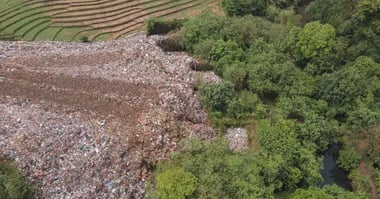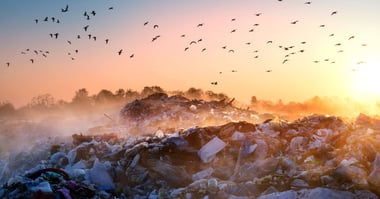
Tamara Davison
Tamara Davison is a journalist who specializes in sustainability and the environment. Reporting from around the world, she's seen firsthand the direct impact waste is having on coastal communities and our oceans. As a diver trained in ecological monitoring, the changes Tamara has seen in marine habitats inspired her to action. She's previously written for The Guardian, The Independent and the Evening Standard. She's also produced environmental documentaries for EuroNews.
For every person on the planet, there are 21,000 pieces of plastic floating in the ocean (Washington Post, 2023). This is just one of countless alarming figures that have emerged about the state of our oceans in recent years.
Marine scientists have warned us for decades that plastic waste jeopardizes our oceans, aquatic life, and human health. Given that around 81% of all marine litter is plastic (according to The Sea Cleaners), it’s unsurprising that this waste has a long-lasting impact.
Despite growing awareness about ocean waste, it simply isn’t going away. The Washington Post also revealed the number of plastic particles in the sea doubles every six years. Here are the latest ocean plastic statistics you need to know.
Want to reduce your business’s plastic footprint? Get in touch with our in-house team to learn about our plastic recovery programs that are helping you do your bit to minimize ocean-bound plastic.
What’s on this page?
01 | How much plastic is in the ocean?02 | How does plastic enter the ocean?
03 | How many microplastics are in the ocean?
04 | What are ocean garbage patches — and how big are they?
05 | Which countries produce the most plastic waste?
06 | The future of ocean plastic pollution
07 | Summary
08 | FAQs
Key findings
- Most scientists agree that there will be more plastic in the ocean (by weight) than fish by 2050 — unless we take drastic action now.
- Around 80% of all plastic starts its life on land. Poor or careless waste management is one of the biggest reasons plastic washes into rivers and the sea.
- There are at least five giant ocean garbage patches, the biggest measuring roughly three times the size of France. Despite efforts to clean them up, they continue to gather new waste every day.
- Around 358 trillion microplastic particles are floating on the surface of our world’s oceans, with countless more found at the depths of the seabed.
How much plastic is in the ocean?
Quantifying the amount of plastic in the ocean is difficult because it could mean anything from giant fishing nets to tiny nanoplastic particles, which are undetectable to the naked eye.
The International Union for Conservation of Nature estimates that 14 million tons of plastic enter our seas annually. That’s equivalent to the weight of five blue whales entering our environment every hour.
On top of this, new research from CSIRO and the University of Toronto estimates that up to 11 million tonnes of plastic pollution is sitting on the ocean floor.
Most ocean-bound plastic (OBP) has a land-based origin. A lot of trash is either mismanaged after disposal or simply thrown into our environment, where it makes its way into rivers and the ocean.
Over 80% of OBP comes from Asia, but it’s worth remembering that many European countries still ship their plastic waste to these countries — so it's not solely Asia to blame.
Another large bulk of plastic waste comes from the fishing industry, which directly throws plastic waste overboard. Estimates suggest that 10% of ocean waste is ghost gear, which describes the fishing nets, traps, and fishing lines lost at sea. Some of the ghost nets are kilometers long, and as they float through the ocean, they can trap wildlife as big as sperm whales inside. Dead marine life caught in the nets weighs them down, making it hard to say how many ghost nets are on the sea bed.
Understanding how much plastic is already in our oceans is a different story. Scientists believe there could be up to 10,000 times more plastic particles on the sea floor than on its surface. As the deepest parts of our ocean are generally inaccessible, it’s hard to tell how much plastic impacts the bottom of our seas.
When combined, the amount of plastic entering the ocean and the amount of plastic already floating in it paints a dire picture of the health of our seas.
To make matters worse, plastic production is expected to grow over the next decade, even though we know its adverse effects. Many scientists have warned that by 2050, more plastic will be in the sea than fish (by weight).
How many plastic bags are in the ocean?
According to The World Counts, humans use an estimated 5 trillion plastic bags every year, and less than 1% of them are recycled. Around 300 million plastic bags enter the Atlantic Ocean alone every year — and that’s just one of our world’s five oceans.
However, determining the exact number of plastic bags in the ocean is almost impossible. Made of flimsy plastic, many quickly break down into small fragments or are ingested by marine life, like sea turtles.
Studies have shown that people use single-use plastic bags for around 12 minutes before being thrown away. Once thrown away, a plastic bag can take up to 20 years to biodegrade, massively polluting the environment.
Scientists believe that over 56% of all marine life has ingested plastic. For crucial marine animals like turtles, the prevalence of plastic bags can prove deadly. Floating bags resemble jellyfish, a key food source for turtles — and when eaten, they can become lodged in their digestive systems.
One account of this is a green turtle that died in 2010 in Brazil — after which scientists discovered 3,267 plastic pieces in its intestines and 308 pieces in its stomach.
Some countries have started taking steps to reduce plastic bag waste. Several US states, such as California and New York, have introduced bans on single-use plastic bags. In the UK, retailers have to charge a minimum of 10p per plastic bag, amazingly leading to a 98% reduction in plastic bag usage.
Despite these efforts to curb plastic bag usage, it isn’t having a global impact, with reports suggesting single-use plastic production is still on the rise.
How many plastic straws are in the ocean?
Again, quantifying this is difficult, but scientists have estimated that up to 8.3 billion plastic straws have washed up on beaches worldwide. Just imagine how many more plastic straws are still floating in our oceans.
Like plastic bags, plastic straws negatively impact marine wildlife and ocean ecosystems. However, this is also one of the most promising areas where people have started to take action.
Particularly among coastal communities, plastic straw campaigns have led to the adoption of alternative materials like bamboo or metal.
In 2018, the Californian town of Malibu banned plastic cutlery and straws to clean up its beaches. Similarly, in the famous Mexican beach town of Puerto Escondido, local shop and restaurant owners teamed up to stop using plastic straws, demonstrating the town’s commitment to clean up its overflowing plastic waste.
How many plastic bottles are in the ocean?
Due to the ocean currents, measuring specific items can be tricky. To provide some insight, Surfers Against Sewage carried out a study and found that there are 5,000 pieces of plastic and 150 plastic bottles for each mile of UK beach. A shocking statistic that sheds light onto this issue.
While we may never know how many plastic bottles are in the ocean, we do know that only one in six plastic bottles in the US get recycled, suggesting that most will pollute our environment.
The UN Environment Programme also revealed that one million plastic bottles are purchased worldwide every minute, most of which are single-use.
Manufacturers make most plastic bottles from polyethylene terephthalate (PET), which is recyclable in most cases. However, if this material is disposed of incorrectly, it can take up to 450 years to break down.
Again, this paints a dismal image of the plastic bottle waste accumulating in our oceans.
How does plastic enter the ocean?
According to Our World in Data, around 80% of all plastic waste in our oceans comes from land, while the rest comes from marine practices. This waste makes its way from land into our oceans in many ways.
In some cases, local communities don’t have waste management infrastructure and dump their plastic waste in local nature or rivers, where it washes into the sea. In other instances, overflowing landfill sites similarly fail to contain waste, meaning it also seeps into waterways heading to the ocean.
You may think most of these problems occur in developing countries, but they happen closer to home, too. In the UK, for example, water firms discharged raw sewage into local waterways 300,000 times in 2022, with reports adding that it included a lot of microplastics.

How many microplastics are in the ocean?
The environmental outlet Monga Bay reported that in 2023, around 358 trillion microplastic particles were floating on the surface of our world’s oceans. Studies have also estimated that 14 million tons more are on the seabed.
Unfortunately, it’s impossible to say exactly how many microplastics are in the ocean. Trillions more are estimated to be floating in the water and circulating our planet because of ocean drifts and currents. We may never really know the true extent of this crisis.
Monitoring microplastic levels in the sea is difficult for obvious reasons: these particles are less than five millimeters in size, so they’re tricky to see. That’s also before we factor in nanoplastics that can be 80 times smaller in width than human hair.
Check out our guide to microplastics to learn more about what they are and how we can remove them from the environment.
What are ocean garbage patches — and how big are they?
Ocean garbage patches are basically large accumulations of trash that gather together and float in our oceans. The movement of this marine debris is dictated by marine gyres (big whirlpool-like currents) that keep all the waste bound together.
According to the National Oceanic and Atmospheric Administration (NOAA), there are currently five main gyres around our planet, contributing to the formation of massive patches of garbage. These can be found in the Pacific, Atlantic, and Indian Oceans.
The most infamous is the Great Pacific Garbage Patch, which experts believe to be around three times the size of France. It’s made up of countless pieces of garbage from around the world, including plastic bottles, fishing nets, and every other piece of trash you can imagine.
Efforts are being made to counter ocean garbage patches. However, progress is slow because of the sheer size of the problem — and because more trash keeps coming. One example of a positive outcome happened in 2023, when The Ocean Cleanup NGO removed about 25,000 pounds of trash in one collection, making it the largest gathering of waste from the patch so far.
Which countries produce the most plastic waste?
All countries produce some degree of plastic waste; however, the management of that waste varies widely.
According to the 2023 Plastic Overshoot Day report, China, the United States, and India produce the most kilotonnes of plastic waste per year. The same report revealed that India, China, and Brazil mismanaged the most waste, suggesting an imbalance between production and waste management.
Again, the results differ when you look at waste produced per capita, with America taking the top spot with 105kg of plastic thrown away per person per year. The United Kingdom came in close second, with people throwing away 99 kilograms of plastic waste per year.
Some statistics omit data about the amount of plastic waste exported to other countries, making it difficult to determine the exact amount of waste thrown away by each country. Reports reveal that, as of 2020, Europe was the biggest exporter of plastic waste. However, it’s also the biggest importer, which highlights the complex nature of plastic movement around the world.
The future of ocean plastic pollution
Unprecedented amounts of plastic waste enter our oceans every single day. It’s clear that we already have a major environmental crisis on our hands, and it’s set to get worse if the mismanagement of plastic waste doesn’t stop. Plastic production is also expected to grow by 40% within the next decade.
It may seem like an endless pursuit, but change is slowly happening, giving us a bit of hope. In 2023, several nations signed the historic High Seas Treaty with the aim of turning 30% of our oceans into protected areas by 2030.
This treaty is specifically geared toward supporting marine life and reducing harmful fishing practices, yet it doesn’t stop plastic from floating in those areas.
The UN also introduced the High Ambition Coalition to End Plastic Pollution, which aims to encourage countries to stop plastic pollution by 2040 by creating a circular economy model for plastic.
Neither of these specifically addresses existing plastic waste, but there are also countless grassroots organizations and startups that have taken this challenge on and helped to reduce ocean-bound plastic.
This includes The Ocean Cleanup (the organization working on the Great Pacific Garbage Patch), Clean Ocean Action, and of course CleanHub, which empowers businesses to stop ocean-bound plastic waste and supports coastal communities in the process.
Summary
It’s hard to imagine living in a world with more trash in our oceans than fish. It’s a world where coral reefs die off en masse, where coastal communities struggle to feed their families, and where toxic chemicals make seawater very uninviting.
Unfortunately, this will happen in our lifetimes unless we take action now.
You may not live near the ocean, but our oceans are connected to our climate, meaning that we all rely on the health of our seas. That’s why stopping plastic from ending up in our oceans should be a priority for all.
Luckily, plenty of incentives and organizations are trying to bring about positive change. Everyone has a part to play in supporting a future free of plastic waste.
Want to reduce your business’s plastic footprint? Get in touch with our in-house team to learn about our plastic recovery programs that are helping you do your bit to minimize ocean-bound plastic.
FAQs
What percentage of the ocean is plastic?
Studies have suggested that around 40% of the ocean’s surface is now covered in plastic. In some cases, this gathers in ocean garbage patches or washes up on our shores. It is impossible to put an exact number on the amount of plastic floating in our oceans.
How much plastic will be in the ocean by 2050?
Many reports suggest that within 26 years, there will be more plastic in our oceans by weight than fish. In numbers, the Ellen MacArthur Foundation predicts that there will be up to 950 million tons of ocean plastic by 2050.
How much plastic is in the ocean in 2024?
It’s thought around 14 million tons of plastic enter our oceans each year, and there could be around 10,000 times more plastic sitting on the sea bed. Unfortunately, we may never know the true extent of plastic waste in our seas, but current estimates suggest we must act now.

.webp)
.webp?width=380&name=River%20waste%20(1).webp)
%20(1).webp?width=380&name=Pile-of-plastic%20(1)%20(1).webp)
.webp?width=380&name=CleanHub-waste-worker%20(1).webp)
.webp?width=380&name=trash%20(1).webp)
%20(1).webp?width=380&name=Plastic-on-the-beach%20(2)%20(1).webp)


.webp?width=380&name=Colourful%20corals%20(1).webp)

.webp?width=380&name=solar-collection%20(1).webp)
